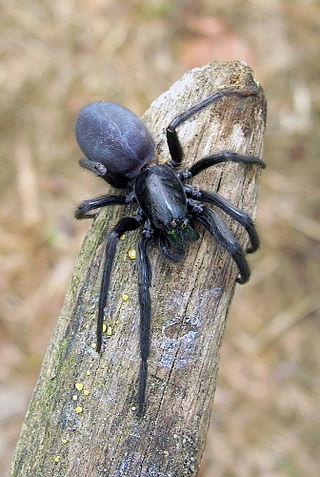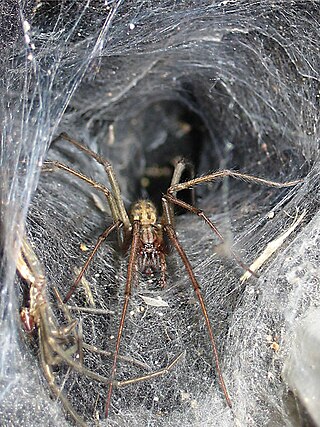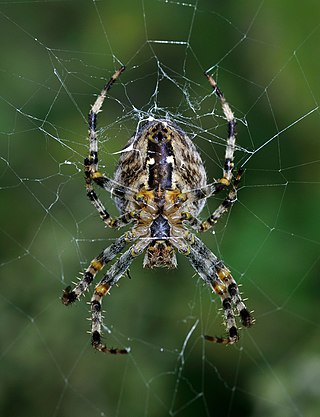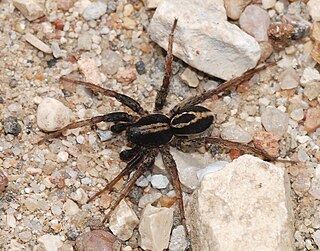
The Mygalomorphae, or mygalomorphs, are an infraorder of spiders, and comprise one of three major groups of living spiders with over 3000 species, found on all continents except Antarctica. Many members are known as trapdoor spiders due to their creation of trapdoors over their burrows. Other prominent groups include Australian funnel web spiders and tarantulas, with the latter accounting for around one third of all mygalomorphs.

Crevice weaver spiders (Filistatidae) comprise cribellate spiders with features that have been regarded as "primitive" for araneomorph spiders. They are weavers of funnel or tube webs. The family contains 18 genera and more than 120 described species worldwide.

Spider taxonomy is that part of taxonomy that is concerned with the science of naming, defining and classifying all spiders, members of the Araneae order of the arthropod class Arachnida with more than 48,500 described species. However, there are likely many species that have escaped the human eye to this day, and many specimens stored in collections waiting to be described and classified. It is estimated that only one third to one half of the total number of existing species have been described.

The Dionycha are a clade of spiders (Araneomorphae:Entelegynae), characterized by the possession of two tarsal claws with tufts of hairs (setae) beside them, which produce strong adhesion, enabling some species to climb glass. The circumscription of the group has varied widely; a 2021 analysis resulted in about 20 families, including Salticidae, Gnaphosidae, and Clubionidae.

Lycosoidea is a clade or superfamily of araneomorph spiders. The traditional circumscription was based on a feature of the eyes. The tapetum is a reflective layer at the back of the eye, thought to increase sensitivity in low light levels. Lycosoids were then defined by having a "grate-shaped" tapetum. Research from the late 1990s onwards suggests that this feature has evolved more than once, possibly as many as five times, so that the original Lycosoidea is paraphyletic. Studies published in 2014 and 2015 suggest that a smaller group of families does form a clade.

Scytodoidea is a taxon of araneomorph spiders, at the rank of superfamily. It contains four families:

The Leptonetoidea are a superfamily of haplogyne araneomorph spiders with three families. Phylogenetic studies have provided weak support for the relationship among the families. The placement of one of the families within the Haplogynae has been questioned.

The Dysderoidea are a clade or superfamily of araneomorph spiders. The monophyly of the group, initially consisting of the four families Dysderidae, Oonopidae, Orsolobidae and Segestriidae, has consistently been recovered in phylogenetic studies. In 2014, a new family, Trogloraptoridae, was created for a recently discovered species Trogloraptor marchingtoni. It was suggested that Trogloraptoridae may be the most basal member of the Dysderoidea clade. However, a later study found that Trogloraptoridae was placed outside the Dysderoidea and concluded that it was not part of this clade.

The Eresoidea or eresoids are a group of araneomorph spiders that have been treated as a superfamily. As usually circumscribed, the group contains three families: Eresidae, Hersiliidae and Oecobiidae. Studies and reviews based on morphology suggested the monophyly of the group; more recent gene-based studies have found the Eresidae and Oecobiidae to fall into different clades, placing doubt on the acceptability of the taxon. Some researchers have grouped Hersiliidae and Oecobiidae into the separate superfamily Oecobioidea, a conclusion supported in a 2017 study, which does not support Eresoidea.

The Deinopoidea or deinopoids are group of cribellate araneomorph spiders that may be treated as a superfamily. As usually circumscribed, the group contains two families: Deinopidae and Uloboridae.

The Agelenoidea or agelenoids are a superfamily or informal group of entelegyne araneomorph spiders. Phylogenetic studies since 2000 have not consistently recovered such a group, with more recent studies rejecting it.
The Dictynoidea or dictynoids are a group of araneomorph spiders that have been treated as a superfamily. The composition of the group has varied. Phylogenetic studies in the 21st century have failed to confirm the monophyly of the dictynoids as originally defined.

The Titanoecoidea or titanoecoids are a proposed taxon of araneomorph spiders at the superfamily rank. The taxon contains two families of spiders, Phyxelididae and Titanoecidae. Although some phylogenetic studies have shown these two families to form a clade, other studies have not, placing Titanoecidae outside the RTA clade while Phyxelididae is placed inside it. A 2011 classification of spider families leaves both Phyxelididae and Titanoecidae outside the RTA clade as "unplaced non-Orbiculariae families". The status of the group remains unclear as of December 2015.

The Austrochiloidea or austrochiloids are a group of araneomorph spiders, treated as a superfamily. The taxon contains two families of eight-eyed spiders:

The Haplogynae or haplogynes are one of the two main groups into which araneomorph spiders have traditionally been divided, the other being the Entelegynae. Morphological phylogenetic studies suggested that the Haplogynae formed a clade; more recent molecular phylogenetic studies refute this, although many of the ecribellate haplogynes do appear to form a clade, Synspermiata.

The Entelegynae or entelegynes are a subgroup of araneomorph spiders, the largest of the two main groups into which the araneomorphs were traditionally divided. Females have a genital plate (epigynum) and a "flow through" fertilization system; males have complex palpal bulbs. Molecular phylogenetic studies have supported the monophyly of Entelegynae.

Orbiculariae is a potential clade of araneomorph spiders, uniting two groups that make orb webs. Phylogenetic analyses based on morphological characters have generally recovered this clade; analyses based on DNA have regularly concluded that the group is not monophyletic. The issue relates to the origin of orb webs: whether they evolved early in the evolutionary history of entelegyne spiders, with many groups subsequently losing the ability to make orb webs, or whether they evolved later, with fewer groups having lost this ability. As of September 2018, the weight of the evidence strongly favours the non-monophyly of "Orbiculariae" and hence the early evolution of orb webs, followed by multiple changes and losses.

The RTA clade is a clade of araneomorph spiders, united by the possession of a retrolateral tibial apophysis – a backward-facing projection on the tibia of the male pedipalp. The clade contains over 21,000 species, almost half the current total of about 46,000 known species of spider. Most of the members of the clade are wanderers and do not build webs. Despite making up approximately half of all modern spider diversity, there are no unambiguous records of the group from the Mesozoic and molecular clock evidence suggests that the group began to diversify during the Late Cretaceous.

Avicularioidea is a clade of mygalomorph spiders, one of the two main clades into which mygalomorphs are divided. It has been treated at the rank of superfamily.

Theraphosoidina is a clade of avicularioid mygalomorph spiders first proposed by Robert J. Raven in 1985, based on a morphological cladistic analysis. Raven included three families: Theraphosidae, Paratropididae and Barychelidae. Subsequent molecular phylogenetic studies upheld the relationship between the Theraphosidae and Barychelidae, but found that Paratropidae fell outside the clade.



















